Do Extensive Rubber Plantation Influences Local Environment? A Case Study From Tripura, Northeast India.
Abhik Majumder1 * , Sadrita Datta2 , Bal Krishan Choudhary3 and Koushik Majumdar3
DOI: http://dx.doi.org/10.12944/CWE.9.3.25
Copy the following to cite this article:
Majumder A, Datta S, Choudhary B. K, Majumdar K. Do Extensive Rubber Plantation Influences Local Environment? A Case Study From Tripura, Northeast India. Curr World Environ 2014;9 (3) DOI:http://dx.doi.org/10.12944/CWE.9.3.25
Copy the following to cite this URL:
Majumder A, Datta S, Choudhary B. K, Majumdar K. Do Extensive Rubber Plantation Influences Local Environment? A Case Study From Tripura, Northeast India. Curr World Environ 2014;9(3).
Available from:http://www.cwejournal.org/?p=7456
Download article (pdf)
Citation Manager
Publish History
Select type of program for download
| Endnote EndNote format (Mac & Win) | |
| Reference Manager Ris format (Win only) | |
| Procite Ris format (Win only) | |
| Medlars Format | |
| RefWorks Format RefWorks format (Mac & Win) | |
| BibTex Format BibTex format (Mac & Win) |
Article Publishing History
| Received: | 2014-07-21 |
|---|---|
| Accepted: | 2014-10-10 |
Total natural rubber cultivation in India wasca 0.74 million ha till 2012. According to Rubber Board of India (RBI),1 India now occupies the first rank in terms of productivity, which are presently at 1819 kg/ha.2 NR is used as raw material in the production of 35,000 items of industrial importance in India, 50% of total NR consume by automobile industry. Although, 89% of area and 92% of production came from small holding with an average size of 0.50 ha.The total area of natural rubber cultivation is sub-grouped into traditional (0.53 Mha) and nontraditional regions, where the traditional regions have the lion share. The state of Kerala and Kanyakumari district of Tamil Nadu in the traditional NR cultivating regions, whereas the non-traditional region are in the states of Maharashtra, Karnataka, Goa , Andhra Pradesh and Odisha as classified by RBI. To further expand the cultivation of NR, North Eastern regions are identified as major potential areas due to its agro-climatically suitability for NR cultivation, accelerated activity of NR cultivation have been taken both public and private participation in the states of Assam, Tripura, Meghalaya, Manipur, Mizoram and Nagal and.1
The rubber constituent of latex is cis-1, 4-polyisoprene having elastic property. It is estimated that, ca 70 to 80 % of the latex is harvested in the form of liquid and rests are cup lump or earth scrap. The bacterial vulnerability of latex and field coagulum is high and thus required immediate and safe storage or processing to protect the quality. The protein constituents act as colloidal stabilizer to keep the latex water dispersible. The composition of fresh latex is complex and variation in constituents may be observed due to clone, plantation managements, climatic and edaphic factors. The main constituents are both organic and inorganic viz. proteins, total solid content, spherical or pear shaped rubber globules, moisture content and the rubber globule is surrounded by a protective layer of proteins and phospholipids. The density of latex varies between 0.958 - 0.986 g/ml. The NR mainly consists of rubber (30-40%), water (55-65%), protein (2-2.5%), resins (1-2%), sugar (1-1.5%) and ash (0.7-0.9%).1,3
Despite the large extension of land covered by rubber, the environmental and socioeconomics impacts of rubber expansion have recently been explored at various scales.4-6 Vegetation dynamics, as well as possible differences in growth rates, leaf turnover and decomposition rates of rubber, might induce changes in carbon stocks and carbon exchange rates.However, more research is needed to verify these claims and to fully understand the hydrological consequences of extensive land-cover conversion to rubber at basin scale.7-8 In this paper an attempt has been made to (1) study the effect NR production on local environment and (2) to assess the ecological implications of NR production in state.
Study Area
Tripura is a small state with 10,486 km2 geographical area in the North-Eastern region of India, located between 22o 56‟ and 24o 32‟N latitude to 90o 09‟ and 92o 20‟E longitudes. The state is a hilly region with altitudes varying from 15 to 940 m above sea level. The climatic condition of Tripura is typical monsoon climate with sub-tropical to temperate conditions. The amount of total annual rainfall in the State varies between 1500-2500 mm. The soils of Tripura arepredominantly red loamy soils, which cover a total area of 4,514 km2 covering about 43.0 % land area of the state. The total NR area estimated through remote sensing for the state was provisionally found to be 58637 ha in all age group including recently planted 1-2 years old, i.e. those are planted during the planting seasons of June 2009-2011.2 The total rubber production of Tripura stands at 25875 Tonnes.
Tripura Forest Development and Plantation Corporation Limited (TFDPCL) adopted rehabilitation of degraded forestland through commercial rubber plantations on 7087 ha area as its primary objective along with sustainable rehabilitation of tribal shifting cultivators in the state of Tripura. The Corporation is the pioneer in developing successful models for permanent settlement of tribal shifting cultivators through rubber cultivation by providing each family 1 ha of Rubber plantation for latex extraction. TFDPCL organized resettlement of more than 1133 scheduled tribe families and 70 scheduled caste families under different schemes and projects and creating employment for around 3585 people directly and to an almost equal number indirectly.
Methodology
We used available data such as quantum of NR production in the state, rainfall statistics,average temperature variation and ground water recharge characteristics of the state provided by various government agencies. NR production data of the state from 2004 to 2010 was collected from the Rubber Board of India (RBI).1 Yearly variation of rainfall and deficiencies in rainfall data available from 2007 to 2012 was obtained from local Indian Meteorological Department (IMD), Agartala.9 Temperature fluctuations data (Degree Celsius) available from 1994 to 2006 was obtained from IMD. The groundwater level from 1999 to 2008 for both South and North Tripura district was obtained from Central Ground Water Board (CGWB).10 The NR processing requirements, present and future estimates of waste effluents generation (from NR processing) was documented and discussed. The climatic data variations were analyzed for rainfall, rainfall deficit and atmospheric temperature rise with ground water level recharge. We also discussed the vegetation of the state and interaction NR plantation with them.
Result and Discussion
Generation of Waste Water and Soil Contamination
There are several methods of processing of NR latex available based on the end products requirement. Preserved field latexis a product where the field latex is preserved by adding additives like ammonia (min 1%). Latex concentrate has a wide industrial application where the field latex is processed into creamed latex by adding creaming agent such as ammonium alginate or tamarind seed powder where the Dry Rubber Content (DRC) of the latex is increased. The other type of latex concentrate is processed in centrifuge, where the DRC is increased up to 60%. In India,about 75% of NR latex is processed into Ribbed Smoked Sheet(RSS)and it is considered as the simplest method of NR processing. In this method, the latex is added with acetic acid or formic acid (about 1:100 dilution in water) and is allowed to coagulated in rectangular shaped containers into thin slabs of coagulum. Then the coagulum is rolled through a set of smooth rollers to a thickness of about 3 mm followed by grooved set rollers and then dried to obtain sheet rubber. In this process the coagulum is continuously washed with water and about 1 liter of running water is required per ½ kg sheet production. The NR production and processing, waste water is mainly generates in the form of reminder water in the rectangular shaped containers, spray of water during thin sheet formation in roller, washing of sheets, containers and factory floor [11]. Environmental pollution and emission of Green House Gasses (GHGs) like CO2 and CH4 from the processing unit especially from the smoke house which is a matter of serious concern as the emitted gases may escalate global warming. The organic constituent of waste water coming out of processing are decomposed by microorganism, where many coli form bacteria grows in course time and may contaminate the adjacent soil and surface water table.
Trends of NR product variation in India as shown in the Table 1; considering almost the same proportion for Tripura, as this is the second NR grower state of India. Hence, at present contribution of RSS to NR production in Tripura is about 18112 Tonnes, which is almost 70% of the 25875 Tonnes of annual NR production of Tripura (RBI). Based on this amount of RSS production, it is suggest that a waste water of about 36224 kiloliter is generated (at the rate of 1 liter per ½ kg of RSS) during RSS production (mainly washing) in Tripura per annum. As per the RBI, the productivity of NR in India is 1867 kg/ha (2008-09, Rubber Board of India). Keeping the above facts in consideration in the next 10 years the NR production of Tripura may be estimated to 109475 Tonnes (considering present 58637 ha of NR Plantation). Thus an increase of about 4.2 times of the present production can be expected. In near future the annual requirement of water in RSS production may escalate to 152140 kiloliters, considering the future estimate of 109475 Tonnes of NR production in the state.The standard process of RSS processing suggests that, to produce ½ Kg RSS sheet 4 liter of latex mixture is required (may slightly vary depending on the dry rubber content in latex region wise). Hence the total quantity of latex used for RSS sheet production is 144896 kiloliter as per present production of RSS (18112 Tonnes). Out of this 144896 kiloliter of latex 89637 kiloliter is water content, considering 65% water content presence in the latex (RBI). Hence production of NR is also accompanied with an indirect groundwater exploration of 89637 kiloliters per annum. This quantity of the water content is essentially the body fluid of the NR tree and is grafted by the plant from the dynamic replinishible groundwater level. But this quantity of water content exploration will soon increase many times, because the effective yielding area under NR production is going to increase each year. Thus an increase of 4.2 times of the present production of RSS NR (18112 Tonnes) may also contribute to indirect ground water exploration of about 376475 kiloliters of water content per annum, considering linear increase in production. The present scenario of NR production in Tripura, the waste water generation is summarized in the Table 2 (only washing of RSS sheet and water content in latex is considered).
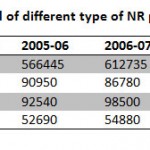 |
Table 1: All India production trend of different type of NR product in Tones. Source:1 Click here to View table |
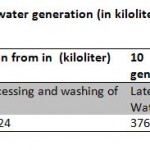 |
Table 2: Future scenario of waste water generation (in kiloliters) during RSS NR production in Tripura. Source:1 Click here to View table |
This is equivalent to filling 21 soccer fields (100 X 60 meter) with waste water of about 1 meter depth at present and 88 of them in next 10 years as projected. Such a huge amount of waste water and effluents so generated in the process of latex collection and processing is mostly dispossessed directly in ambiance of the processing center. The rapid growth of the sector will accelerate the generation of effluents in near future. Beside the waste water (which includes ammonium, sulphate, and other acids) the NR processing industries also breeds a small amount of un-coagulated latex and serum with small quantities of protein, carbohydrates, lipids, carotenoids and salts. The present condition of waste water and other effluent treatment scenario in the state of Tripura is very poor. Except some few organized industry in the state, others are discharging it directly to the atmosphere, thus inviting serious health hazards and environmental degradation.Mohammadi et al. (2010) in their study suggested the general characteristics of rubber waste water, and it shows the presence of considerable amount of suspended solid and sulphate.12
Depletation of Groundwater Table
Analysis of the available ground water data of the state shows that, during April to August 1999, there is no decline of ground water level from 0 to 4 meter BGL. Whereas 42.11% and 57.89% rise in the groundwater level was observed at 0-2m level and at 2-4m level respectively. But a more recent data show for a long period trend of groundwater level (1999 to 2008), which is given in theTable 3 for South and North Tripura.10 The important aspects of the above observation is that, there were no fall in ground water level in 1999, but the trend changes significantly and fall of ground water level is observed both in pre monsoon and post monsoon season in some parts of south Tripura, in the range of 0.011 to 0.205 m/year. Under the ground water utilization pattern in India as on 2004, the ground water draft in Tripura both for domestic and industrial purpose is more than 15% which is far above then the national average of 8%.13 This attributes to the depleted ground water level in the state of Tripura. Natural landscape processes as processes in undisturbed natural forests had less negative on hydrological functions.14 Rather, adverse effects on environment and hydrological functions occurred due to human interference for expansion of agriculture. According to Marc and Robinson (2007),the evaporation under forest lands is significantly different from such under grassland fields.15 This in turn showed differences in water balance between catchments dominated by forest and grasslands. Accordingly, stream flow and runoff were found higher in grasslands than under forest lands. The forest lands showed differences among each other due to variation in age of the forest in which catchments with forest of older age experienced lower evaporation rates as compared to such with younger forest. However, before canopy closure soil exposure to rainfall and thus risk of runoff was higher than the matured forest stands. The simulated study showed greater water losses occurs through rubber evapotranspiration from rubber dominated landscapes compared with traditional vegetation.16
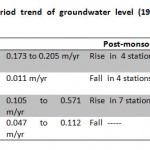 |
Table 3: shows a long period trend of groundwater level (1999 to 2008) for South and NorthTripura Source:10 Click here to View table |
Rubber tree is blamed to be the cause of the dramatic downward trend in fog frequency between the mid-1950s and the mid-198 0s.4,17 However, Wu et al. (2001) showed surface runoff and soil erosion increases as a result of conversion of tropical forest to rubber monoculture in Xishuangbanna.17 With regard to rubber water consumption, extensive field observations in Xishuangbanna suggest that rubber trees are depleting the subsurface water resources, as significant water uptake occurs during leave flushing coinciding with the driest and hottest period of the year.16 In addition, rubber trees are responsible for accelerated suction of ground water and cause more water loss from the earth surface due to greater plant to plant distance as compared to rainforest vegetation, resulting reduced surface runoff and deplete in ground water.18 A recent case study conducted by the International Union for Conservation of Nature and Natural Resources (IUCN, 2011) reveals significant degradation of water level in streams and ponds, disappearance of various aquatic species and increasing cost of drinking water and food and people are no longer collecting non timber forest products fearing contamination due to rubber plantation.19
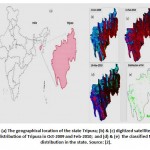 |
Figure 1: (a) The geographical location of the state |
Impacts on Local Rainfall and Temperature
The overall rainfall statistic for the year 2008 to 2012of Tripura is shown in Figure 2. The average rainfall in the state is 2043.82 mm from year 2008 to 2012. As already mentioned rainfall is the primary determinant factor in crop production. The rainfall is highly variable in terms of length of the season and amount of rainfall in the state. The deficiency of rainfall in the state as compared with LPA (Long Period Average) is shown in Figure2. The trend is showing an overall deficiency of rainfall for the year 2008 to 2012. The monsoon rainfall deviation for the period of June & July in Tripura is minus 23.3% for the period (IMD). In the absence of rain, the scenario may become susceptible towards intense drought periods.20 The precipitation interception of rubber tree canopy is seasonal. The water holding capacity of the canopy is low. The average annual interception rate of rubber tree canopy is 11.45% of the rainfall. The water loss from rubber plantation in the form of water from soil might be negligible but nutrient loss is significant. Around 50% of the rainwater flows down the slope (through run-off, but mainly lateral flow in the soil), feeding the deep permanent groundwater level. Transpiration of the young rubber trees is still very low (average 0.2 mm/d) but should be multiplied by 10 for adult trees (2mm/d). At this stage the trees can't have any incidence on water table draw down. The Rubber tree tends to reduce the flow of water and also tends to dry the moist land. Thus, probably influences the regulation of the hydrological cycle. However, in NR plantation the undergrowth is eliminated, which may typically retains enough water without evaporation, and slowly releases it to the soil. The infiltration level of rainwater depends upon the type of plantations and plantation tends to have a lower infiltration level, which is why it promotes erosion processes and a reduction in the aquifers recharge.21
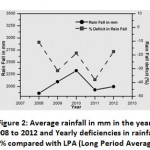 |
|
While, from the analysis of local average maximum and minimum temperature during 1994 to 2006 it sis suggested that the average temperature increases annually in Tripura. Record of temperature data of the state is available from 1994 to 2006, which shows that both the average maximum and minimum temperature are increasing significantly. The increase is observed to be more in case of average minimum temperature as shown in the Figure 3. The rise in temperature may be coherent with the global warming and climate change. Eventually, the continuous rise in temperature will contribute to the accelerated evaporation of water from all natural sources of water. Rubber tree suffers cold damage when temperatures fall below 5oC or remain below 10oC for a prolonged period of time. On the other hand, rubber yield reduces when temperatures are above 28oC. Assuming that changes in rubber yield and evapotranspiration are triggered by the same temperature thresholds with minimum and maximum bounds of 10oC and 28oC [22]. Rubber closes its stomata when vapor pressure deficit rises above 3Ð5 Kilo pascal (KPa), with the largest latex flow occurring when deficit is below 1Ð2 kPa. As the stomata close, transpiration is reduced. Photoperiod or day length E (DL) of Rubber needs sunny with 2000 h of sunshine per year (with at least 6 h/day in all months.23-24 Additionally, with the raise of temperature, the soils under the plantation may also release absorbed carbon and, when the timber is harvested, the carbon inevitably returns to the atmosphere.
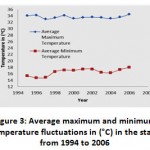 |
Figure 3: Average maximum and minimum temperature fluctuations in (°C) in the state from 1994 to 2006 Click here to View figure |
Effect of Rubber on Soil
The rubber plantation are develop on the degrade forest land. The tree were planted by spacing them into 4.5m apart and characterized by deciduous litter fall within short period, good canopy cover and often face intermittent weed & litter collection for fuel by local people. Soil is characterized by horizontal distribution of root in top layer and low organic carbon percentage. Rubber Plantation was traditionally not grown in the state. Forest to rubber plantation conversion is an important land use change and reserve forests were not compared with rubber plantation in terms of its carbon sequestration potential. Soong (1976) noticed a feeder root concentration of 28-50 % in top 7.5 cm in Malaysian soil. In a review,Soil Organic Carbon (SOC) wasdecrease 0-30% for intensified rubber plantation in Southeast Asia.25 According to Varghese et al. (1996) in their study on five year old Rubber Plantation from Tripura showed that there was not any definite pattern of pH across soil depth (range 4.22 to 4.80) but percentage of Organic Carbon (OC) decreases with depth and it varies from 0.97 (0-18 cm) to 2.11 (36-54 cm).26 The concentration of fine root in top layer (0-18 cm) was highest and it varied from 33% to 76%. Soil under rubber plantation is strongly acidic (pH 4.51±0.07) and sandy loam in texture; while soil of the mixed forest in surrounding of rubber plantation was highly acidic (pH 4.62± 0.06) and sandy clay loam in texture.27 The conversion of natural forest into deciduous mono culture of rubber might be expected to disrupt this pattern of spatial and temporal controls over nutrient cycling. For example, most of the leaf fall in the rubber plantation occurs in a two month dry period. Following the onset of monsoon, the litter decomposes rapidly with a half-life (t50) of about 30 days, leads to rapid leaching of nutrients. Below ground fluxes of carbon and nutrient in rubber plantations are influenced by soil moisture availability and when soil moisture stress is more severe, fine root production and turnover and consequent nutrient cycling is more.There is evidence that fast-growing trees have an extractive effect upon soil fertility and that they tend to impoverish the soil and unbalance its structure.21 Although, recent studies suggested that rubber management practices significantly affected soil C, N, pH, soil moisture and vegetation (including plant diversity and quantity of plant litter and roots) and thus affected soil nematode communities.28
Shrinking of Natural Forest Areas and Loss of Diversity
Forests of Tripura are mainly tropical semi evergreen to moist deciduous type. Forest covers about half of the 6292.681 sq km are of the state and out of total forest cover, 3588.183 sq km are Reserve Forests (RF), 509.025 sq km are Proposed Reserve Forests (PRF) and Unclassified Govt. Forests (UGF) is 2195.473 sq km based on satellite data.29 The flora of Tripura comprising 1545 species and 28 extra-typical varieties in 862 genera and 193 families of vascular plants, representing about 12.86% of the Flora of India.30 In Tripura, 8.94% of the geographical area is covered with bamboo forest. Plantation of various species covers an area of 218503.68 ha of which teak, sal and rubber constitutes the major part. The miscellaneous hardwood forest with bamboo consists of 17.43% and 4.15% of the geographical area. Several species like sissoo, kanak, koroi, garjan, rubber, tea, and coffee etc. plantation were also developed by clearing natural forests. Among which rubber plantation alone consists of about 36,000 ha and recent trends of rubber mono plantation are increased especially in private sectors. Since its immense market demands, good quality of latex and suitable climate and soil of the state enhance its priority compared to other plantation crops due to first hand returns (within 5-6 years). Tree density generally remain 111 trees / ha and tree volume varies between 21- 28 m.3 Being a mono culture technique, rubber plantation generally develops by completely clearing previous forest stands and managed by annual clearing the ground flora. Due to regular maintenances for latex collection and canopy shielding, plant diversity is very poor under this plantation. Only few shade tolerant herbs and shrubs can exists. However, some trees are kept inside or in the boarding the plantation for shade, fencing and timber requirements. A recent study found that diversity and density of trees in rubber plantation including its marginal forest fragments were low compared to other semi-natural plantation and natural vegetation.29,31 The common species ofthe ground vegetation of rubber plantation includeAltenthera sp., Cleodendrumviscosum, Pavetaindica, Spilanthuspaniculata, Desmodium sp., Blumiasp, Agiratumconyzoides, Spermacoseaehispida, Rungiapectinata, Momosapudica, Eupatorium odoratum etc. Some seedling of trees like Microcuspaniculata, Mallotustetracoccus, Suragadamultilocureetc.with fewgrasses species could be found. Rubber plantations do not provide any food or foraging items for birds and other wildlife, they can use it for shelter only and forced to feeds on nearby agricultural lands or orchards which may increase man-wildlife conflicts. Present. It is now recognized that land-cover transitions to rubber monocultures are responsible for significant losses of aboveground and belowground biomass and carbon stocks32-33 and biodiversity.5,8,and34
Other Ecological Impacts
The all India production of NR reaches highest yield during the period of September to January. The month wise production (in Tonnes) data of NR released by Rubber Board of India is shown in Figure4 for the year 2007-08. The similar trend of NR production can also be observed in the state of Tripura. This variation in month wise NR production is mainly due to undisturbed NR harvesting in post monsoon season and less harvesting of NR during the dry winter season. But the annual rainfall deficit of 23.3 % in the state together with the depleted ground water level and significant rise in average maximum and minimum temperature may severely hit the production of NR in the region. Moreover, the maximum yielding period of NR is observed to be after the monsoon season and ranges from Sept to Jan as shown in Figure 4. This is followed by the dry period where the rainfall is least especially in the month of January to March.
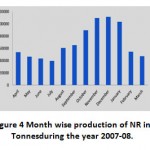 |
Figure 4: Month wise production of NR in Tonnesduring the year 2007-08. Click here to View figure |
The continuous tapping of latex from plant takes place in the period extending from August to March. However, the continuous tapping of latex from August to March not only causes a huge waste water generation of about 125861 kiloliter annually in Tripura, in form of water content in latex (89637 kiloliter estimated) and processing and washing of RSS (36224 kiloliter estimated); but also causes serious imbalance in the ground water level. Beside this, the root of the rubber trees does not penetrate much in ground.35 Strong wind during rainy seasons can easily bend the tree and uproot the whole plant including top soil, which may accelerate soil erosion. NR being a deciduous tree leaves generally fall during December to February. These slow degradable thick leaves may not retain enough moisture on the ground and prevent through blocking the soil pores the easy rain water penetration into ground during rainy season. Persistent collection of field latex in the post monsoon and dry season will cause the ground water level to deplete further. Moreover, the systematic NR plantation and collection of field latex will cause localize effects on the ground water level. This indirect ground water withdrawal in the form of latex will not be replenished immediately if there is no rainfall. Such situation may invite serious life threat to other plant species due to non availability of ground water or fall of ground water level at the local effected zone. To quantify such effects more accurately, much study is needed. Moreover it is observed that the NR plantation is mostly dominated by Heveabrasiliensis species and unlike natural forest virtually there exists no other vertical layer of plant species and establish a threat to local flora and.36 Upper canopy typically cut the light penetration and few shade loving weeds may accumulate on the ground space. The descend leaf, dry tree and fallen branches takes long periods to degrade, which can slow down the process of natural humus development and soil formation. Such situation in turn effects the suitable growth and survival of soil macro and microorganisms. Lower level of soil microorganism could effects the typical process of N2 and C fixation and metabolism. The absence of thick ground grass mat or herbs cover accelerates quick runoff of rain water from earth surface. Moreover, regular visits or walking plant to plant for latex collection results compaction of top soil layer which intern reduces the porosity of soil further; which may leads to more resistance to easy ground water absorption. However, extensive use of chemical fertilizer (two times / annum) could accelerate unwanted growth of weeds and algal bloom or eutrophication when run off meets to adjacent surface water body. Thus it can cause indirect water pollution and effect fishery and agricultural production.NR plantations are also easily affected by insect and rodents, which may be the safe corridor for many pest and diseases followed by subsequent loss of vegetation. The wood is soft, it can easily destroy by light storm; and, thus creates huge gaps remained underutilized. Rubber trees are also prone to fires and hence may cause rapid loss of entire biodiversity, economy and release of huge emissions in the atmosphere.Extensive NR plantation may cause the unwillingness among the local population towards settled agriculture systems and traditional crop conservation practices. By privileging cash crop from NR plantations, the local communities may restrict traditionally practiced rice, wheat, vegetable and fruit production; thus may promote artificial shortage of food and corps.
Figure 5 showing the ground water recharge due to rainfall in the projected NR cultivation area of 58637 ha in Tripura from 2007-12, is calculated from the rainfall data and (10% recharge due to rainfall for Tipam sandstone being major water bearing formation of the soil). The analysis shows that the nature of water recharge (in mcm) is highly fluctuating and has inherent dependency on the amount of rainfall. Data available from CGWB for north and south Tripura shows that, in these two undivided districts, there are 6.89% and 7.13% of ground water development took place up to 2004 for both domestic and industry and counting further. Such rapid exploitation of the ground water resource will also accelerate and will cause further depletion of surface waterlogged bodies mainly in the least rainy season. This may cause serious water shortage in different part of the state for drinking and other domestic use, fisheries, cattle’s as they are mostly dependent on surface water bodies.The water content in latex (89637 kiloliter estimated) is mostly dumped near the processing center. There by causing continuous consumption of ground water in the plantation field without refill mostly in the month of least rainfall as shown in the Figure 5.Analysis of 53 year data in Kerala showed the pattern of less rainfall is not significant but rainfall and number of rainy days showed a declining trend during monsoon season and declining rate is 0.9 mm per year for December.37 The annual increase in maximum temperature was found to be0. 04% C per year and 0.02% per year for minimum temperature. Yearly mean daily sunshine hours showed a very high significant negative trend over the years. A decrease of 0.03 hours per year has been noted annually. Decrease in sunshine hours was found highly significant in post monsoon season.38
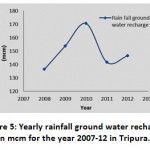 |
Figure 5: Yearly rainfall ground water recharge |
Conclusion
The over all status of NR production of Tripura is studied in terms of quantity. As per the Rubber Board of India, the productivity of NR in India is 1867 kg/ha (2008-09). Keeping the above facts in consideration future estimate of NR production of Tripura in a few years may cross 109475 Tonnes (considering present 58637 ha of NR Plantation). Thus an increase of 4.2 times of the present production can be expected and in near future the requirement of water in RSS production may escalate to 152140 kiloliters of water. The cumulative effect of average deficit rainfall of about 23.3%, continuous average maximum and minimum temperature rise and depleted ground water level of the state may cause a potential threat to environmental balances. The untreated or partly treated effluents of NR production may also cause contamination of surface and ground water, soil and air. This potential threat to environment arose from rubber processing due to untreated effluents, may be treated by microbiological species to reduce the environmental damage.39-40 It is also observed that the current data of relative climatic conditions of the region are insufficient to quantify the overall impact of NR cultivation on local environment. But,accelerated suction of ground water and greater water losses through rubber evapotranspiration from rubber dominated landscapes compared with traditional vegetation have already.41 Considering these aspects, large scale NR plantation may hit ecological balance of the state severely, which was not possible to establish in the present work quantitatively due insufficient field data. Thus more comprehensive long term and localized study is required to quantify the effects of parameters like (i) annual rainfall deficit, (ii) depleted ground water level and (iii) average maximum and minimum temperature rise of the state on NR plantation and ecological balance. This will enable to estimate and predict more correctly the nature and extent of environmental damage.Instead of NR monoculture there should need to introduce NR polyculture model. The indigenous agroforestry model should be incorporated within NR plantation. There also need further investigation on the of socioeconomic and environmental sustainabilityof rubber based Agro-ecosystem models. Such action will help to adopt accurate and suitable preventive measures, to protect the environment and growth of NR production simultaneously. Suitable and modern sustainable technology of pollution control may be implemented, to reduce the contamination of surface and ground water, soil and air.
Acknowledgment
The author(s) acknowledge the support and help received from National Institute of Technology, Agartala, Rubber Board of India, Indian Meteorological Department, Agartala station and Central Ground water Board, India.
Refrences
- RBI. Rubber Board of India, Bulletins. Kerala. Govt. of India (2012). http://rubberboard.org.in/Publication.asp. Retrieved in November 2013.
- Jacob J. and Raj U. Geospatial Technology For Acreage Estimation of Natural Rubber and Identification of potential Areas for its Cultivation in Tripura State. National Remote Sensing Centre ISRO, Govt. of India and Rubber Research Institute of India Rubber Board, Min. of Commerce & Industry, Govt. of India (2012).
- Ochigbo S. S., Lafia-Araga R. A. and Suleiman M. A. T., Comparison of two creaming methods for preparation of NR latex concentrate from field latex. African Journal of Agricultural Research, 12(6), 2916-2919 (2011).
- Liu W., Huabin Hu, Youxin Ma, and Hongmei L., Environmental and Socioeconomic Impacts of Increasing Rubber Plantations in Menglun Township, Southwest China. Mountain Research and Development, 26 (3): 245–253 (2006).
- Li H., Aide T.M., Ma Y., Liu W., Cao M., Demand for rubber is causing the loss of high diversity rain forest in SW China. Biodiversity and Conservation, 16(6): 1731–1745 (2007).
- Li H., Ma Y., Aide T.M., Liu W., Past, present and future land- use in Xishuangbanna, China and the implications for carbon dynamics. Forest Ecology and Management, 255(1): 16–24 (2008).
- GururajaRao G., SanjeevaRao P., Rajagopal R., Devakumar A.S., Vijayakumar K.R., Sethuraj M.R., Influence of soil, plant and meteorological factors on water relations and yield in Heveabrasiliensis. International Journal of Biometeorology, 34(3): 175–180 (1990).
- Ziegler A.D., Fox J.M., Xu J.,The rubber juggernaut. Science,324: 1024–1025(2009b).
- IMD. Climate diagnostics bulletin of India post-monsoon season. Government of India, Ministry of Earth Sciences, India Meteorological Department (2012).http://www. imdpune.gov.in/research/ncc/climatebulletin/post_monsoon_2012.pdf.
- CGWB. Ground Water Information Booklet South and North Tripura District, Tripura; Central Ground Water Board, North Eastern Region, Ministry of Water Resources, (2012) http://cgwb.gov.in/District_Profile/Tripura/South%20Tripura.pdf,Retrieved in November 2013.
- Tekasakul P., Tekasakul S., Environmental Problem Related to NR production in Thailand.Journal of Aerosol Research, Feature article, 21(2): 122-129(2006).
- Mahmoud M. B., Barakaat A., El-Sayed S.M. and El-Aassar S.A., Degradation of NR by Achromobactor sp. NRB and Evalution of Culture Conditions.Polish Journal of Microbiology, 54(1): 55-62 (2005).
- Chatterjee R., Poruhit R. R., Estimation of Replenishable groundwater resources of India and their status of Utilization. Current Science, 96(12): 25(2009).
- Chuan G.K., Hydrological Studies and Water Resource Concerns in Southeast Asia. Singapore Journal of Tropical Geography, 24(1): 86-110(2003).
- Marc, V. and Robinson, M.,The Long-term water balance (1974-2004) of uplandforestry and grassland at Plynlimon, Mid-Wales. Hydrological and Earth System Sciences, 11(1):44-60 (2007).
- Guardiola C. M., Troch P. A., Ziegler A. D., Giambelluca T. W., Vogler J. B., Nullet M. A. Local hydrologic effects of introducing non-native vegetation in a tropical catchment. Ecohydrology, 1: 13–22(2008).
- Wu Z. L., Liu H. M., Liu L.Y., Rubber cultivation and sustainable development in Xishuangbanna, China. International Journal of Sustainable Development and World Ecology 8: 337–345(2001).
- Qiu, J., Where the rubber meets the garden. Nature 457: 246–247 (2009).
- IUCN. Annual Report.2011. https://cmsdata.iucn.org/downloads/ annual_report__iucn_ 2011 .pdf.Retrieved in January 2014.
- Datta M., and DasChaudhuri D., An Over view in Tripura. ICAR Research Complex for North East Hill Region, Tripura Centre, Lembucherra (2012).
- WRM,Tree Plantation: Impacts and struggles a selection of the articles published in the World Rainforest Movements (WRM) Bulletins. (1999).
- Priyadarshan P.M., Sasikumar S., Goncalves P.D.S., Phenologicalchanges in Heveabrasiliensis under differential geo-climates. The Planter, 77(905): 447–459 (2001).
- Priyadarshan P.M., Breeding Heveabrasiliensis for environmental constrains. Advances in Agronomy, 79: 351–400 (2003).
- Priyadarshan P.M., Clement-Demange A., Breeding Hevea rubber: formal and molecular genetics. Advances in Genetics, 52: 51–114 (2004).
- Brunn T.B., Andreas N., Deborah L. and ZieglerA. D., Environmental Consequences of the Demise in Swidden Cultivation in Southeast Asia: Carbon Storage and Soil Quality. Human Ecology, 37:375-88 (2009).
- Varghese P., RaoD.V.KN.,Varghese M., VinodK.K.,PothenJ. and KrishnakumarA.K., Spatial Distribution of Roots And Nutrients in Soil Under Rubber Plantations in Tripura. Indian Journal of Natural Rubber Research, 9(2) : 106-111 (1996).
- Chaudhuri P.S., Bhattacharjee S., Dey A., Chattopadhyay S. and Bhattacharya D., Impact of age of rubber (Heveabrasiliensis) plantation on earthworm communities of West Tripura (India).Journal of Environmental Biology, 34: 59-65 (2013).
- Xiaoa H. F., Tianb Y. H., Zhoub H. P., Aib X. S., Yanga X. D., Schaefera D. A. Intensive rubber cultivation degrades soil nematode communities in Xishuangbanna, southwest China. Soil Biology and Biochemistry, 76: 161–169 (2014).
- Majumdar K., Shanker U. and Datta B. K., Tree species diversity and stand structure along major community types in lowland primary and secondary moist deciduous forests in Tripura, Northeast India. Journal of Forestry Research, 23(4): 553−568 (2012).
- Deb D. B., TheFlora of Tripura State. Vols.I–II. Today and Tomorrow’s Printers and Publishers, New Delhi (1981& 1983).
- Majumdar K., Shanker U. and Datta B. K., Trends in Tree Diversity and Stand Structure during Restoration: A Case Study in Fragmented Moist Deciduous Forest Ecosystems of Northeast India. Journal of Ecosystems, vol. 2014, Article ID 845142, 10 pages, (2014).
- Guo, L. B., Gifford, R. M. Soil carbon stocks and land use change: a meta analysis. Global Change Biology, 8(4): 345-360 (2002).
- Bunker D.E., De C.F., Bradford J.C., Colwell R.K., Perfecto I., Phillips O.L., Sankaran M., Naeem S., Species loss and aboveground carbon storage in a tropical forest. Science 310: 1029–1031 (2005).
- Ziegler A.D., Bruun T.B., Guardiola C.M., Giambelluca T.W., Lawrence D., Nguyen T. L., Environmental consequences of the demise in Swidden agriculture in SE Asia: geomorphological processes. Human Ecology 37(3): 361–373 (2009a).
- Akhtar F., Sen A. R., Haque M. E., Dafader N. C., Siddique F. R. and Al-, Mahmood A. J., Study on the Characteristic Properties of the Field Latex of Bangladesh, Polymer-Plastics Technology and Engineering, 34(2):167-175 (1995).
- Cotter M., Martin K. and Sauerborn J., How Do “Renewable Products” Impact Biodiversity and Ecosystem Services – The Example of NR in China, Journal of Agriculture and Rural Development in the Tropics and Subtropics, 110 (1): 9-22(2009).
- Mall, R. K., Singh, R., Gupta, A., Srinivasan, G. and Rathore, L. S., Impact of climate change on Indian agriculture: a review. Climatic Change, 78(2-4): 445-478 (2006).
- Dani, K. K., P. Ernest Raj, DevaraP. C. S., PandithuraiG., SonbawneS. M., MaheskumarR. S., SahaS. K., and RaoY. J., Longâ€term trends and variability in measured multiâ€spectral aerosol optical depth over a tropical urban station in India. International Journal of Climatology, 32( 1): 153-160 (2012).
- Berekaa, M.M., Barakaat A., El-Sayed S.M., and El-Aassar S. A., Degradation of natural rubber by Achromobacter sp. NRB and evaluation of culture conditions. Polish Journal of Microbiology, 54(1): 55-62 (2005).
- Cherian E., andJayachandran K., Microbial Degradation of NR Latex by a novel species of Bacillus sp. SBS25 isolated from Soil.International Journal of Environment Research, 3(4): 599-604(2009).
- Maite G. C., Peter A. T., ZieglerA.D., Thomas W., Giambelluca M. D., VoglerJ. B. and Michael A. N., Hydrologic effects of the expansion of rubber (Heveabrasiliensis) in a tropical catchment. Ecohydrology 3: 306–314(2010).






